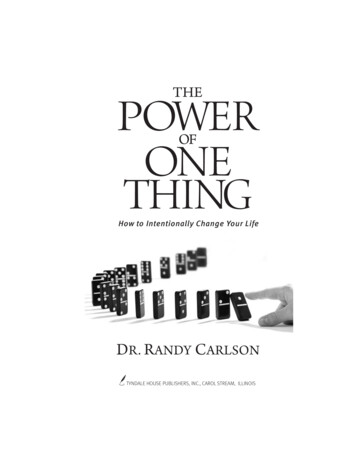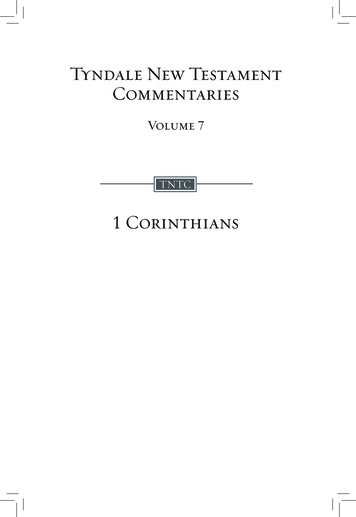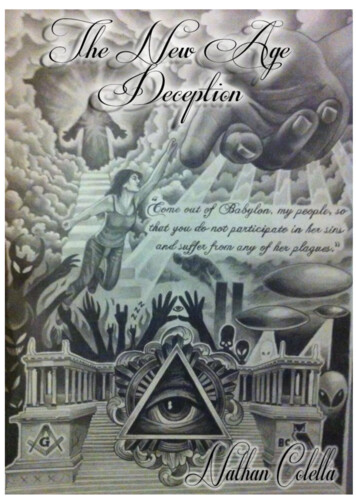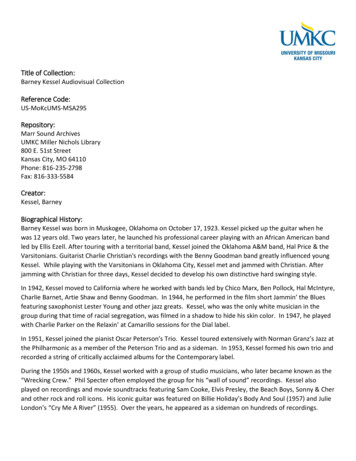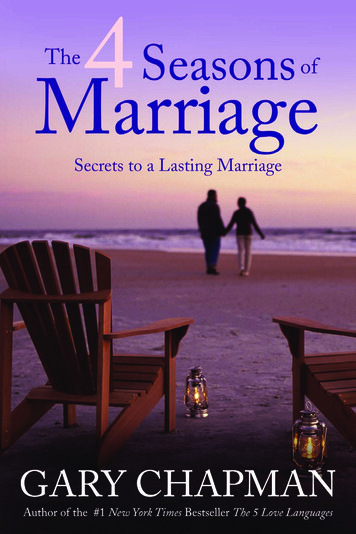
Transcription
Seasons4Marr ageTheof
Seasons4Marr ageTheofSecrets to a Lasting MarriageGARY CHAPMANAuthor of the #1 New York Times Bestseller The 5 Love Languages
Visit Tyndale online at www.tyndale.com.TYNDALE and Tyndale’s quill logo are registered trademarks of Tyndale House Publishers, Inc.The 4 Seasons of MarriageCopyright 2005 by Gary Chapman. All rights reserved.Cover photograph copyright Purestock/Getty Images. All rights reserved.Author photo copyright by Boyce Shore & Associates. All rights reserved.Designed by Ron KaufmannEdited by Dave LindstedtAll Scripture quotations, unless otherwise indicated, are taken from the Holy Bible, New International Version. NIV. Copyright 1973, 1978, 1984 by Biblica, Inc. Used by permission of Z ondervan. All rightsreserved worldwide. www.zondervan.com.The Library of Congress has cataloged the original edition as follows:Chapman, Gary D., date.The four seasons of marriage / Gary D. Chapman.p. cm.ISBN 978-1-4143-0020-7 (hc)ISBN 978-1-4143-0023-8 (sc)1. Marriage—Religious aspects—Christianity. I. Title.BV835.C4575 2005248.8′44—dc22Repackage first published in 2012 under ISBN 978-1-4143-7634-9.Printed in the United States of America18 17 16 157 6 5 414 13 123 2 12005009145
ContentsnAcknowledgmentsIntroductionPart IThe Four Seasons of MarriageThe Nature of Marriage . . . . . . . . . . . . . . . . . . . . . . . . . . . . . . . . . . . . . 3Winter. . . . . . . . . . . . . . . . . . . . . . . . . . . . . . . . . . . . . . . . . . . . . . . . . . . . 9Spring. . . . . . . . . . . . . . . . . . . . . . . . . . . . . . . . . . . . . . . . . . . . . . . . . . . . 21Summer. . . . . . . . . . . . . . . . . . . . . . . . . . . . . . . . . . . . . . . . . . . . . . . . . . 33Fall . . . . . . . . . . . . . . . . . . . . . . . . . . . . . . . . . . . . . . . . . . . . . . . . . . . . . . 49Marital Seasons Profile. . . . . . . . . . . . . . . . . . . . . . . . . . . . . . . . . . . . . . 61nPart IISeven Strategies to Enhancethe Seasons of Your MarriageStrategy 1Deal with Past Failures. . . . . . . . . . . . . . . . . . . . . . . . . . . . . . . . . . . . . . 69Strategy 2Choose a Winning Attitude . . . . . . . . . . . . . . . . . . . . . . . . . . . . . . . . . . 83Strategy 3Learn to Speak Your Spouse’s Love Language. . . . . . . . . . . . . . . . . . . . 95
Strategy 4Develop the Awesome Power of Empathetic Listening. . . . . . . . . . . 107Strategy 5Discover the Joy of Helping Your Spouse Succeed. . . . . . . . . . . . . . . 119Strategy 6Maximize Your Differences. . . . . . . . . . . . . . . . . . . . . . . . . . . . . . . . . . 135Strategy 7Implement the Power of Positive Influence . . . . . . . . . . . . . . . . . . . . 145nPart IIIPutting Your Plan into PracticeMoving Forward from Here and Now. . . . . . . . . . . . . . . . . . . . . . . . . 167Four Seasons Q&A . . . . . . . . . . . . . . . . . . . . . . . . . . . . . . . . . . . . . . . . 171nPart IvThe Four Seasons of Marriage Study GuidePart I. . . . . . . . . . . . . . . . . . . . . . . . . . . . . . . . . . . . . . . . . . . . . . . . . . . . 185Part II. . . . . . . . . . . . . . . . . . . . . . . . . . . . . . . . . . . . . . . . . . . . . . . . . . . 203Part III . . . . . . . . . . . . . . . . . . . . . . . . . . . . . . . . . . . . . . . . . . . . . . . . . . 217nNotes
IntroductionnThe tall and stately elm outside my window is covered with snowtoday. It’s late January and winter has arrived in North Carolina.Schools are closed, as are most businesses, and the streets and lawnsare swathed in a beautiful blanket of white. In the cozy comfort ofmy study, I sit by the fireplace and reflect.I remember the summer we first moved to this place. Across theyard, the elm tree was engaged in a life-and-death struggle witha kudzu vine. The broad-leaved kudzu was winning, choking thelife out of the hapless tree. Looking down the creek, I saw othertrees that had already succumbed. Their dead limbs had fallen andtheir trunks, still pointing to the sky, were covered with snakingvines. They were simply waiting for the next strong wind to topplethem.Although I had arrived too late to save those other trees, I wasdetermined to rescue the elm. With my sharpened, steel vine cuttersin hand, I attacked the kudzu with a vengeance, circling the treeand severing every vine in sight. The larger ones were two inchesin diameter, and the smallest was half an inch. Finally, I retreatedfrom the battle and waited for nature to run its course. Within aweek, the kudzu leaves had shriveled, and I imagined that the elmtree was breathing easier.Summer soon faded into fall and fall into winter. When springcame, the elm tree put out its slender leaves in happy defiance of thegray tendrils still hanging limply over its branches. By the time sum
GARY CHAPM ANXIImer rolled around again, the dead kudzu vines had fallen and theelm tree had a new lease on life.Since then, I’ve watched the seasons come and go. I’ve seen theelm drink up the spring rains, soak in the summer rays of the sun,relinquish its leaves to the winds of fall, and cloak itself with whitebeauty in winter.Today, as I sit here by the fire, gazing at the winter portrait outside my window, I’m also reflecting on the seasons of my life andmy career as a marriage counselor. I’m thinking of the forty-twoyears that Karolyn and I have lived together as husband and wife,and I’m reminded that we, too, have passed through many winters,springs, summers, and falls.I once heard a speaker say that there are four seasons to marriages. As he explained it, we begin as young couples in the springtime of life, excited about the future. Then comes summer, in whichwe become involved in vocations and perhaps child rearing. Aftersummer comes fall, when the children leave and we are alone again.Then, in our latter years of life, we experience winter. Althoughthere is some truth in this analogy, it seems to me a much too simplistic description of marriage.My experience, both in my own marriage and in counseling couplesfor more than thirty years, suggests that marriages are perpetuallyin a state of transition, continually moving from one season to another—perhaps not annually, as in nature, but just as certainly andconsistently. Sometimes we find ourselves in winter—discouraged,detached, and dissatisfied; other times we experience springtime,with its openness, hope, and anticipation. On still other occasionswe bask in the warmth of summer—comfortable, relaxed, enjoyinglife. And then comes fall with its uncertainty, negligence, and apprehension. The cycle repeats itself many times throughout the life of amarriage, just as the seasons repeat themselves in nature.
INTRODUCTIONThe purpose of this book is to describe these recurring seasons ofmarriage, to help you and your spouse identify which season yourmarriage is in, and to show you how to move away from the unsettledness of fall or the alienation and coldness of winter towardthe hopefulness of spring or the warmth and closeness of summer.The seven strategies laid out in the second part of the book will notkeep your marriage from experiencing fall and winter; but they willgive you positive steps you can take to make the most of each season,prepare for the next, and advance your marriage into spring andsummer.The seasons of marriage come and go. Each one holds the potential for emotional health and happiness, and each one has itschallenges. The key is to develop the necessary skills to enhance yourmarriage in all four seasons.Unlike trees, which are at the mercy of the weather and otherfactors, as humans we have the capacity to make decisions. We canchoose attitudes and actions that will improve and strengthen ourmarriages. We can plant seeds of love and hope in the springtimethat will produce fruit during the summer. And we can harvest astorehouse of good feelings and open communication that will prepare us to weather the changes of fall and the icy cold of winter.If you have picked up this book in the dead of winter in yourmarriage, take courage. There’s hope. I have watched hundreds ofcouples apply these strategies and experience the “blooming of thecrocuses” in their relationships. I believe that these practical stepswill work for you as well. Even if you’re reading this book alone andyour mate is not willing to participate, I will show you how to starton your own to win back your spouse’s heart and move your marriage toward a warmer season.If your marriage is currently in spring or summer, it’s importantnot to let the kudzu vines gain a foothold in your relationship. I willXIII
GARY CHAPM ANshow you how to cut the tendrils of negative attitudes and actionsand free your marriage to be all that God designed it to be.If you find the book helpful, I hope you will share it with yourmarried friends, who are also experiencing the four seasons of marriage.XIV
Pa rt I
The Nature ofMarriageIn the early days of my career, I was an avid student of anthropology. During my under graduate and graduate studies in thatdiscipline, I explored ethnographies compiled through the yearsby various anthropologists. One conclusive finding of these studies was that marriage between a man and a woman is the central,social building block in every human society, without exception.It is also true that monogamous, lifelong marriage is the universalcultural norm.Of course, some people will deviate from this practice, as inpolygamy (which is still found in a few nonliterate cultures)and serial monogamy (which has become common practice insome Western cultures), but these exceptions do not erase thecultural norm of lifetime monogamy from the human psyche.In fact, in spite of the widespread acceptance of divorce in theUnited States over the past forty years, a recent poll of nevermarried singles ages twenty to thirty indicates that eighty-sevenpercent planned to marry only once.1 Many of these people haveseen their parents divorce and that is not what they want for themselves.The social institution of marriage is first and foremost a cove
GARY CHAPM AN4nant relationship in which a man and a woman pledge themselvesto each other for a lifetime partnership. In the biblical account ofcreation, God’s expressed desire is that the two “will become oneflesh.”2 At the heart of marriage, therefore, is the idea of unity. Itis the opposite of aloneness. Again from the creation account inGenesis, it is abundantly clear that God did not intend for menand women to live alone.3 Something deep within a man cries outfor companionship with a woman, and the woman has a similardesire for intimacy with a man. Marriage is designed to satisfy thisdeep search for intimacy. Thus, marriage is not simply a relationship; it is an intimate relationship that encompasses all aspectsof life: intellectual, emotional, social, spiritual, and physical. Ina marriage relationship, a husband and wife share life with eachother in the deepest possible way. They view themselves as a unified team, not as two individuals who happen to be living in closeproximity. Because the desire and drive for intimacy are at thevery heart of marriage, the individuals involved become troubledabout their relationship when such intimacy is not attained.Marriage is also a purposeful relationship. All research indicates that an intimate marriage provides the safest and mostproductive climate for raising children, for example. But procreation is not the only purpose of marriage. Each person isalso endowed by God with certain latent possibilities. Thepartner ship of marriage is an ideal environment for nurturingand developing these gifts and abilities. As the writer of theancient book of Ecclesiastes observes, “Two are better than one. . . If one falls down, his friend can help him up. But pity theman who falls and has no one to help him up!” 4 Every marriedcouple has experienced the reality of this principle. Two arebetter than one.Husbands and wives are designed to complement each other.
The Nature of MarriageWhen the man is weak, his wife is strong; when she stumbles, heis there to pick her up. Life is easier when two hearts and mindsare committed to working together to face the challenges of theday.The Essential Nature of taryAfter forty-plus years of marriage, I look back and realize thatmany of the things I have accomplished would never have cometo fruition were it not for the encouragement and help of mywife. I’d also like to think that she has accomplished more withher life because of my support. This brings me a great deal ofsatisfaction. Together we have committed ourselves to seek andfollow God’s plan for our lives. We help each other discover ourunique giftedness and encourage each other to use these abilitiesto serve God and to promote good in the world. As we do this,our lives point others to God and we accomplish our highest end.Our marriage relationship enhances the effectiveness with whichwe serve God.King David captured the vision for us in Psalm 34:3: “Glorifythe Lord with me; let us exalt his name together.” From a biblical perspective, the purpose of life is not to accomplish our ownobjectives. The purpose of life is to know God and to bring gloryand honor to his name. For most people, marriage enhances thepossibility of achieving this objective.5
GARY CHAPM AN6Adapting to the Changing SeasonsMarriage relationships are constantly changing. Attitudes shift,emotions fluctuate, and the way spouses treat each other ebbsand flows between loving and not so loving.Sometimes, change is beyond our control. For example, whenBen’s wife, Nancy, was told she had cancer, the diagnosis changedthe fabric of their lives and their relationship. They could adaptto the situation, but they couldn’t control it. The same was trueof Tricia and her husband, Rob, a member of the National Guard.When his unit was activated, he was sent into a war zone half aworld away. Rob and Tricia could adapt, but the circumstanceswere beyond their control. When it became clear to Jon and Carolthat her mother could no longer live alone, they had to respondto a change that they couldn’t control. Life is full of unanticipatedchanges. Our only choice as couples is in how we will respond.Other changes we create for ourselves, but sometimes withunexpected consequences. When Ken and Melinda moved toKansas City after living near her family in Chicago for ten years,it created numerous changes that they now had to face together.The decisions we make regarding vocation, child rearing, education, civic and church involvement, and other areas of life createchanges that affect our marriage relationships. The manner inwhich couples process these changes will determine the qualityof their marriages.In the natural world, the four seasons are created by certaininevitable changes that occur as the earth turns on its axis andrevolves around the sun. Likewise, the changes we face in life (andthe way we process and respond to them) create the seasons ofmarriage. The birth of a baby, the death of a loved one, illness, in-laws, getting a job, losing a job, the demands of a job, travel,vacations, weight gain, weight loss, financial ups and downs,
The Nature of Marriagemoving, staying, depression, disagreements, moods, teenagers,aging bodies, aging parents, hobbies, habits, sex, impotence, infidelity—all these are examples of situations and circumstancesthat put pressure on a marriage and demand a response. If werespond well, in harmony with our spouse, we can keep our marriage in spring or summer. If we don’t respond well or if ourresponse clashes with our spouse’s response, we can feel the chillof autumn or be thrust into the icy cold of winter—sometimesbefore we know what hit us.Some changes, such as sexual infidelity, strike at the very heartof a marriage. Other changes are simply a natural part of life, suchas illness, aging, or a new job. Our response to change consistsof emotions, attitudes, and actions. The combination of thesethree factors will determine which season our marriage is in atany given time.The thesis of this book is that the natural seasons—winter,spring, summer, and fall—provide us with an apt analogy for thechanges that occur in our marriage relationships. As we experience life through the five senses—hearing, seeing, smelling, tasting, and touching—we feel emotions, develop attitudes, and takeaction. The interweaving of our emotions, attitudes, and actionscreates the quality of our relationship in the various seasons ofmarriage.It has become popular in Western culture over the past fortyyears to exalt emotions as the guiding light that determines ouractions. After more than thirty years of counseling couples, I amconvinced this is a misguided notion. Don’t misunderstand me:I am not suggesting that emotions are not important. Emotionstell us that something is wrong or right in a relationship, but emotions must lead to reason, and reason must be guided bytruth if we are to take constructive action. We must not short-7
GARY CHAPM ANcircuit the process and jump straight from emotions to actionwithout the benefit of reason. Many couples who have done thishave found themselves in winter when they could have ended upin spring or summer.EMOTIONS moderated by REASON guided by TRUTH CONSTRUCTIVE ACTION8Let’s begin our journey by defining the four seasons of marriage.In the next four chapters, we will look at the common emotions,attitudes, and actions that create a particular season. We will dothis by visiting with couples who have chosen to communicate tome the joys and sorrows of their season of marriage. Names andplaces have been changed to protect the privacy of the couplesinvolved, but the stories are real and for the most part are told inthe words of the people themselves.Perhaps you will discover yourself in one of these seasons ofmarriage. If not, the Marital Seasons Profile at the end of Part Iwill help you identify the season of your marriage. In the secondpart of the book, I will introduce seven practical ideas for weaving your emotions, attitudes, and actions together to move fromone season to another.In Part III, we’ll recap the seven strategies and answer some ofthe common questions I’ve been asked about the four seasons ofmarriage.Finally, to help you use this book in a small-group setting,or to facilitate your own understanding, we’ve included a studyguide intended to promote conversation about the four seasonsof marriage and the seven strategies. My hope is that all these features will help you and your spouse enhance the seasons ofyour marriage.
GARY CHAPMAN XII mer rolled around again, the dead kudzu vines had fallen and the elm tree had a new lease on life. Since then, I’ve watched the seasons come and go. I’ve seen the elm drink up the spring rains, soak in the summer rays of the sun, relinquish its leaves to the win



